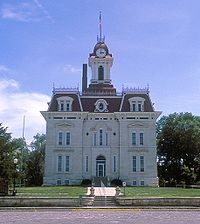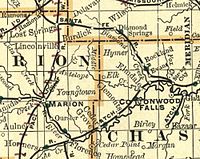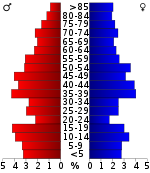- Chase County, Kansas
-
Chase County, Kansas 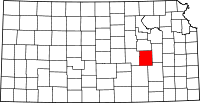
Location in the state of Kansas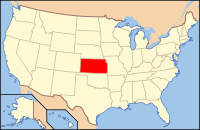
Kansas's location in the U.S.Founded February 11, 1859 Named for Salmon P. Chase Seat Cottonwood Falls Area
- Total
- Land
- Water
778.01 sq mi (2,015 km²)
775.89 sq mi (2,010 km²)
2.12 sq mi (5 km²), 0.27%Population
- (2010)
- Density
2,790
4.0/sq mi (1.5/km²)Time zone Central: UTC-6/-5 Website ChaseCountyKS.org Chase County (county code CS) is a county located in Central Kansas, in the Central United States. As of the 2010 census, the county population was 2,790.[1] Its county seat and most populous city is Cottonwood Falls.[2] Chase County is part of the Emporia Micropolitan Statistical Area.
The county has been the subject of a book by William Least Heat-Moon. Notre Dame coach Knute Rockne died in a 1931 plane crash in the county. The Tallgrass Prairie National Preserve was established in the county in 1996. The center of population of Kansas is located in Chase County, about four miles north of Strong City.
The county should not be confused with the city of Chase, which is located in Rice County.
Contents
History
19th century
The south-western border one mile "notch" into Marion County was established under unusual circumstances. A murder had occurred and Marion County didn't want to have the trial, so a section one mile wide and eighteen miles long was ceded to Chase County to ensure the murder had occurred there.[3] The one mile strip of land remains in Chase County to this day.
In 1887, Atchison, Topeka and Santa Fe Railway built a branch line from Neva (3 miles west of Strong City) to Superior, Nebraska. This branch line connected Strong City, Neva, Rockland, Diamond Springs, Burdick, Lost Springs, Jacobs, Hope, Navarre, Enterprise, Abilene, Talmage, Manchester, Longford, Oak Hill, Miltonvale, Aurora, Huscher, Concordia, Kackley, Courtland, Webber, Superior. At some point, the line from Neva to Lost Springs was pulled but the right of way has not been abandoned. This branch line was originally called "Strong City and Superior line" but later the name was shortened to the "Strong City line".
Law and government
Following amendment to the Kansas Constitution in 1986, the county remained a prohibition, or "dry", county until 1988, when voters approved the sale of alcoholic liquor by the individual drink with a 30% food sales requirement.[4]
Geography
Chase County is centrally located in the eastern half of the state in the Flint Hills geologic region. According to the 2000 census, the county has a total area of 778.01 square miles (2,015.0 km2), of which 775.89 square miles (2,009.5 km2) (or 99.73%) is land and 2.12 square miles (5.5 km2) (or 0.27%) is water.[5]
Adjacent counties
- Morris County (north)
- Lyon County (east)
- Greenwood County (southeast)
- Butler County (southwest)
- Marion County (west)
National protected area
Major highways
Sources: National Atlas,[6] U.S. Census Bureau[7]
- Interstate 35 All of I-35 in Chase County is part of the Kansas Turnpike and inaccessible to the general public from within the county. The closest access points are via U.S. Route 50 in Emporia or Kansas Highway 177 in Cassoday. There is a private interchange located southeast of Bazaar for loading cattle. The overpass names the interchange the "Bazaar Cattle Crossing."[8]
- U.S. Route 50
- Kansas Highway 150
- Kansas Highway 177
Demographics
Historical populations Census Pop. %± 1860 1,046 [9] — 1870 1,975 88.8% 1880 6,081 207.9% 1890 8,233 35.4% 1900 8,246 0.2% 1910 7,527 −8.7% 1920 7,144 −5.1% 1930 6,952 −2.7% 1940 6,345 −8.7% 1950 4,831 −23.9% 1960 3,921 −18.8% 1970 3,408 −13.1% 1980 3,309 −2.9% 1990 3,021 −8.7% 2000 3,030 0.3% 2010 2,790 −7.9% U.S. Decennial Census As of the U.S. Census in 2000,[10] there were 3,030 people, 1,246 households, and 817 families residing in the county. The population density was 4 people per square mile (2/km²). There were 1,529 housing units at an average density of 2 per square mile (1/km²). The racial makeup of the county was 96.90% White, 1.02% Black or African American, 0.56% Native American, 0.13% Asian, 0.56% from other races, and 0.83% from two or more races. Hispanic or Latino of any race were 1.75% of the population.
There were 1,246 households out of which 28.30% had children under the age of 18 living with them, 54.60% were married couples living together, 7.60% had a female householder with no husband present, and 34.40% were non-families. 31.10% of all households were made up of individuals and 14.90% had someone living alone who was 65 years of age or older. The average household size was 2.34 and the average family size was 2.92.
In the county the population was spread out with 24.10% under the age of 18, 6.50% from 18 to 24, 26.60% from 25 to 44, 24.10% from 45 to 64, and 18.70% who were 65 years of age or older. The median age was 40 years. For every 100 females there were 103.90 males. For every 100 females age 18 and over, there were 99.40 males.
The median income for a household in the county was $32,656, and the median income for a family was $39,848. Males had a median income of $27,402 versus $21,528 for females. The per capita income for the county was $17,422. About 4.10% of families and 8.60% of the population were below the poverty line, including 10.00% of those under age 18 and 6.30% of those age 65 or over.
Cities and towns
Incorporated cities
Name and population (2006 estimate):[11]
- Cottonwood Falls, 955 (county seat)
- Strong City, 580
- Matfield Green, 62
- Cedar Point, 55
- Elmdale, 51
Unincorporated places
- Bazaar
- Birley
- Clements
- Gladstone
- Homestead
- Hymer
- Matfield Green
- Rockland
- Rural
- Saffordville
- Toledo
- Wonsevu
Ghost towns
- Clover Cliff
- Elk
- Ellinor
- Morgan
- Neva
- Thurman
Townships
Chase County is divided into nine townships. None of the cities within the county are considered governmentally independent, and all figures for the townships include those of the cities. In the following table, the population center is the largest city (or cities) included in that township's population total, if it is of a significant size.
Education
Unified school districts
- USD 284, Chase County
- Cottonwood Falls, Strong City, Matfield Green, Cedar Point, Elmdale, Clements, Saffordville, Bazaar, Rural Areas
- Chase County Junior/Senior High School
- District Office In Neighboring County
- USD 398, Peabody-Burns
- Wonsevu, Rural Areas
- Peabody-Burns Junior/Senior High School
Literature
Made famous by William Least Heat-Moon's epic book PrairyErth: A Deep Map (1991).
NRHP sites
The following sites in Chase County are listed on the National Register of Historic Places:
- Cartter Building, Cottonwood Falls
- Cedar Point Mill, Cedar Point
- Chase County Courthouse, Cottonwood Falls
- Chase County National Bank, Cottonwood Falls
- Clements Stone Arch Bridge, Clements
- Clover Cliff Ranch House, Elmdale
- Cottonwood River Bridge, Cottonwood Falls
- Cottonwood River Pratt Truss Bridge, Cedar Point
- Crocker Ranch, Matfield Green
- Fox Creek Stone Arch Bridge, Strong City
State Historical Markers
- A Landmark of Distinction - The Chase County Courthouse
- Chase County & The Bluestem Pasture Region of Kansas
- The Bluestem Pasture Region of Kansas
- W. B. Strong Memorial Railroad Park
See also
Information on this and other counties in Kansas
- List of counties in Kansas
- National Register of Historic Places listings in Kansas
- Kansas locations by per capita income
Other information for Kansas
- List of cities in Kansas
- List of unified school districts in Kansas
- List of colleges and universities in Kansas
References
- ^ "2010 County Population and Housing Occupancy Status". U.S. Census Bureau. http://factfinder2.census.gov/faces/tableservices/jsf/pages/productview.xhtml?pid=DEC_10_PL_GCTPL2.ST05&prodType=table. Retrieved March 31, 2011.
- ^ "Find a County". National Association of Counties. http://www.naco.org/Counties/Pages/FindACounty.aspx. Retrieved 2011-06-07.
- ^ Kansas State Historical Society - Marion County
- ^ "Map of Wet and Dry Counties". Alcoholic Beverage Control, Kansas Department of Revenue. November 2006. http://www.ksrevenue.org/abcwetdrymap.htm. Retrieved 2007-12-26.
- ^ "Census 2000 U.S. Gazetteer Files: Counties". United States Census. http://www.census.gov/tiger/tms/gazetteer/county2k.txt. Retrieved 2011-02-13.
- ^ National Atlas
- ^ U.S. Census Bureau TIGER shape files
- ^ Google Maps Street View
- ^ The census population cited for 1860 includes Otoe county which was annexed before 1870. In 1860, the census population was 808 for Chase and 238 for Otoe.
- ^ "American FactFinder". United States Census Bureau. http://factfinder.census.gov. Retrieved 2008-01-31.
- ^ "Population Estimates". U.S. Census Bureau, Population Division. http://www.census.gov/popest/estimates.php. Annual estimates of the population to { {LookupUSEstPop|2015900|EDT}}. Released 2007-06-28.
Further reading
- History of the State of Kansas; William G. Cutler; A.T. Andreas Publisher; 1883. (Online HTML eBook)
- Kansas : A Cyclopedia of State History, Embracing Events, Institutions, Industries, Counties, Cities, Towns, Prominent Persons, Etc; 3 Volumes; Frank W. Blackmar; Standard Publishing Co; 944 / 955 / 824 pages; 1912. (Volume1 - Download 54MB PDF eBook), (Volume2 - Download 53MB PDF eBook), (Volume3 - Download 33MB PDF eBook)
External links
- County
- Chase County - Official Website
- Chase County - Directory of Public Officials
- Chase County - Chamber of Commerce
- Chase County - Information, Skyways
- Historical
- Maps
- Chase County Map, KDOT
- Kansas Highway Map, KDOT
- Kansas Railroad Map, KDOT
- Kansas School District Boundary Map, KSDE

Morris County Morris County Lyon County 
Marion County 
Lyon County  Chase County, Kansas
Chase County, Kansas 

Butler County Butler County Greenwood County Municipalities and communities of Chase County, Kansas Cities Townships Bazaar | Cedar | Cottonwood | Diamond Creek | Falls | Homestead | Matfield | Strong | Toledo
Unincorporated
communitiesGhost towns Elk | Ellinor | Neva | Thurman
Categories:- Kansas counties
- Chase County, Kansas
- 1859 establishments in the United States
- Emporia micropolitan area
Wikimedia Foundation. 2010.

